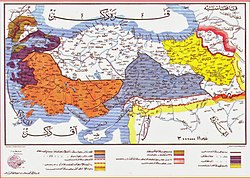Western Armenia
Western Armenia (Armenian: Արևմտյան Հայաստան), also referred to as Byzantine Armenia, later Turkish Armenia, or Ottoman Armenia is a term coined following the division of Greater Armenia between Byzantine Empire (Western Armenia) and Persia (Eastern Armenia) in 387 AC. Today, it is mostly a term used for eastern parts of Turkey (formerly the Ottoman Empire) that were part of the historical homeland of Armenians.[1][2]
History
After the death of Armenian king Arshak III, in 390 AC, the Western Armenia was governed by Greek generals.[2][3] In the 7th century Western Armenia was one of the centers of Pavlikian Christian popular sect.[4] Since 9th century the most part of Western Armenia included Vaspurakan and Taron was under the rule of Bagratid dynasty of Armenia. Then the Zakarid Armenia of 13-14th centuries included some parts of Western Armenia.
After Turkish-Persian wars of 1602-1639 Western Armenia became part of Ottoman Empire.[1] Since Russo-Turkish War, 1828-1829 that term is referred to the Armenian-populated historical regions of the Ottoman Empire that remained under Ottoman rule after the eastern part was ceded to the Russian Empire.
Western (Ottoman) Armenia was composed of six vilayets (vilâyat-ı sitte), the vilayets of Erzurum, Van, Bitlis, Diyarbekir, Kharput, and Sivas.[5] After the collapse of Ottoman Empire Western Armenia remained under Turkish rule, and in 1894–96 and 1915 Turkey perpetrated systematic massacres and forced deportations of Armenians.[6]
After the Armenian genocide the distinct Western Armenian[7] dialect of the Armenian language (recognized as one of the major dialects of Armenian [2] Archived 2007-12-17 at the Wayback Machine) is spoken primarily in Istanbul, Lebanon, Egypt, other parts of Armenian diaspora, and formerly in eastern Turkey.[8] It differs orthographically from Eastern Armenian, there are also phonological differences. In some parts of the diaspora, the Armenian schools, such as L'École Arménienne Sourp Hagop and the Armenian Sisters Academy instruct Western Armenian to the students, instead of Eastern Armenian, the official dialect of the Republic of Armenia.
Modern period
The fate of Western Armenia — commonly referred to as "The Armenian Question" — is considered as a key issue in the modern history of the Armenian people.[9] The first and second congresses of Western Armenians took place in Yerevan in 1917 and 1919. Since 2000, an organizing committee of congress of heirs of Western Armenians who survived the Armenian Genocide is active in diasporan communities.[10]
Publications
- Dr Arman Kirakosian, English Policy towards Western Armenia and Public Opinion in Great Britain (1890-1900), Yerevan, 1981, 26 p. (in Armenian and Russian).
Western Armenia Media
The planned partition of the Ottoman Empire according to the superseded Treaty of Sèvres of 1920
The modern concept of United Armenia as claimed by the Armenian Revolutionary Federation.Orange: areas overwhelmingly populated by Armenians (Republic of Armenia: 98% and Javakheti: 95%)Yellow: Historically Armenian areas with presently no or insignificant Armenian population (Western Armenia, Nakhichevan and Nagorno-Karabakh)
A 1927 version of the map used by the Grand National Assembly of Turkey (later restored)
Related pages
References
- ↑ 1.0 1.1 [1] Archived 2023-05-31 at the Wayback Machine"Феодальный строй (Great Soviet Encyclopedia, in Russian)".[dead link]
- ↑ 2.0 2.1 "Рыжов К. В. Все монархи мира: Древний Восток: [Справочник]. - М.: Вече, 2006 (in Russian)".[dead link]
- ↑ s:Catholic Encyclopedia (1913)/Mesrob
- ↑ "Византия (Great Soviet Encyclopedia, in Russian)".[dead link]
- ↑ "Armenia". www.worldstatesmen.org.
- ↑ "Britannica Online: Armenia".
- ↑ "АРМЯНСКИЙ ЯЗЫК, «Литературная энциклопедия» (М., 1929-1939. Т. 1-11)".[dead link]
- ↑ "UCLA Language materials Project page: Armenian". Archived from the original on 2011-03-22. Retrieved 2007-12-02.
- ↑ "Books and Publications - Gomidas Institute". www.gomidas.org.
- ↑ "A1Plus – Լուրեր Հայաստանից". www.a1plus.am. Archived from the original on 2016-03-19. Retrieved 2019-02-11.







